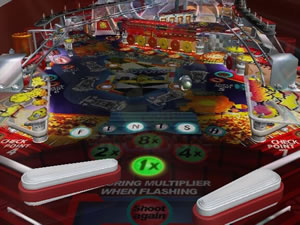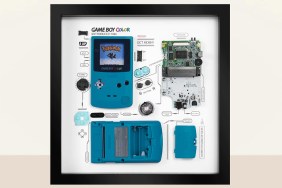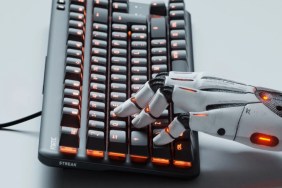A mean pinball.
Downhill skiing can be fun, but tying a sled to the back of a car can be equally satisfying, albeit low-tech and old-school. Wearing a bicycle helmet over a ski-mask might be a low-tech solution to the lack of mudflaps on import cars and the lack of professionally sanctioned safety equipment for motor-driven sledding, but wearing only goggles and a stocking cap keeps it real, thus making it old-school. Low-tech is using your mother’s sewing kit to stitch the head wounds incurred after going road-sledding, old-school style.
This subtle distinction is indispensable in analyzing Crave’s Pinball Hall of Fame: The Gottlieb Collection, a game that promises old-school, but delivers low-tech.
I can’t say that I jumped at the opportunity to review Pinball Hall of Fame, but I have to admit that I was qualified for the task. To me, pinball is not only low-tech, but it is also gloriously old-school. I sometimes daydream about it, even when I appear to be listening to you. Beneath this hearing, speaking, and seeing exterior of a man there is a deaf, dumb, and blind kid who sure plays a mean pinball.
And only that deaf-mute child in me could appreciate Crave Entertainment’s recent foray into video game pinball. While other pinball video games invent their own tables, Pinball Hall of Fame faithfully reproduces seven of Gottlieb’s “classic” tables spanning the decades between the 1950’s and the early 1990’s. This was an inspired idea, capturing the nostalgia of pinball while, at the same time, cashing in on proven table designs without having to worry about being creative.
However, this choice begs the question: who is the intended audience for this game? The earliest table included, “Ace High,”was built in 1957; assuming that one must be at least sixteen to be of legitimate soda fountain age, that makes its clientele over sixty today. Converse All-Stars are old-school, but saddle shoes and penny loafers are just old.
Each of the tables includes a brief historical segment detailing its significance in the evolution of pinball. It’s not much, but it’s a nice touch. Reading that the table called “Central Park” was “considered one of the best playing classical tables in 1966” reminds you that, at one time, “Central Park” was both new-school and high-tech.
This is important because “Central Park” is obscenely difficult – and, if not for the history lesson, you’d probably believe it impossible. The fact that long ago some teen “gamers” were able to master its half-inch paddles and six wide-open drains is amazing, and for a second, motivating.
Crave also added a collection of unlockables to reward you for competing with the ancients. Each table is assigned a goal; some are as simple as knocking down all of the drop-targets, while others demand feats as Herculean as accumulating 16 credits in “Ace High.” Completing these gains access to mini-games like the electronic fortune teller Zulten (not to be confused with Zoltar, who turned a little boy into Tom Hanks and then, to the relief of everyone, reversed his heinous curse) and features like the ability to play with a pinball that looks like a basketball.
 The game also saves high-scores and your overall progress in the game up to that point, but it doesn’t save anything else, like unlocked features. I discovered this the day after a grueling evening of pinball. After several hours of repetitive pinball later, I regained all the lost ground. Conscientiously, I tried to save, but was prevented by the unimaginable lack of a manual save function. Then I looked in the options menu and spotted a promising choice called “autosave,” but it was already turned on. What gives?
The game also saves high-scores and your overall progress in the game up to that point, but it doesn’t save anything else, like unlocked features. I discovered this the day after a grueling evening of pinball. After several hours of repetitive pinball later, I regained all the lost ground. Conscientiously, I tried to save, but was prevented by the unimaginable lack of a manual save function. Then I looked in the options menu and spotted a promising choice called “autosave,” but it was already turned on. What gives?
Well, it turns out the only time the “autosave” ever kicks in is when a high score is set, which means that if you unlock a goal and don’t set a high score (which frequently happens, especially with the less fun, more difficult tables) you have to play again and again until you complete the goal and beat a high score. Playing to save the game so you can quit is not playing at all – it’s work. I actually caught myself saying, “Just make a game out of it and it’s not so bad.”
But Pinball Hall of Fame is already a game, and, overlooking the save glitch for a moment, it performs adequately. The physics – arguably the most important part of any pinball videogame – are fine. The ball bounces around realistically, even making subtle adjustments when it has a faintly discernable spin. Flippers are controlled by the L1 and R1 buttons and are not pressure-sensitive, which is an authentic touch; old-time pinball flippers weren’t pressure-sensitive, either. The R3 button operates the “nudge” function, which is difficult to use yet essential to passing the more difficult tables.
No amount of nudging, however, could get me past the well-named table, “Black Hole,” since my ball would repeatedly disappear and then the whole game would freeze. Combine this “disappearing ball’ glitch with the aforementioned “inability to save’ glitch and you get the “I refuse to play this game’ glitch.
 While admirable for its old-school potential, the Pinball Hall of Fame ultimately delivers a very low-tech experience. The flippers feel weak, especially in the older games. Besides a few of the more recent tables, there is no music at all, and the music from the 80’s-era games is repetitive and annoying. Crave tried to generate the background noise of an arcade using clicks, whistles and obscure mumblings, but the result sounds more like a nature scene featuring an occasional lonely zombie than it does an arcade. A classic rock n’ roll jukebox would have been old-school. Moaning zombie noise is definitely low-tech.
While admirable for its old-school potential, the Pinball Hall of Fame ultimately delivers a very low-tech experience. The flippers feel weak, especially in the older games. Besides a few of the more recent tables, there is no music at all, and the music from the 80’s-era games is repetitive and annoying. Crave tried to generate the background noise of an arcade using clicks, whistles and obscure mumblings, but the result sounds more like a nature scene featuring an occasional lonely zombie than it does an arcade. A classic rock n’ roll jukebox would have been old-school. Moaning zombie noise is definitely low-tech.
The tables, though, are beautiful. Each scantily-clad pin-up pinball woman is painted in loving detail behind glittery bumpers. Unfortunately, much of the detail is lost in the more helpful camera angles. The most exquisite angle views the ball from about an inch away, following it through its colorful journey straight down the drain. The most helpful camera angle is posiitoned about three feet above the table, and though the table looks messy from above, at least you have a fighting chance to hit the ball…until you eventually give up on this buggy game.
And you will give up, because despite its old-school charm, Pinball Hall of Fame feels very low-tech. Sure, people used to enjoy
catching balls in cups and playing
paddle-ball, and they were probably pretty swell at these games too, but that doesn’t mean that
chasing a hoop with a rod will ever make a very good video game. As it turns out, neither does Pinball Hall of Fame: The Gottlieb Collection.
-
Authentic, old pinball tables
-
That look good
-
But are way too old and difficult
-
No replay value
-
No manual save?
-
Inexcusable glitches
-
Promise, but no delivery, of zombies











